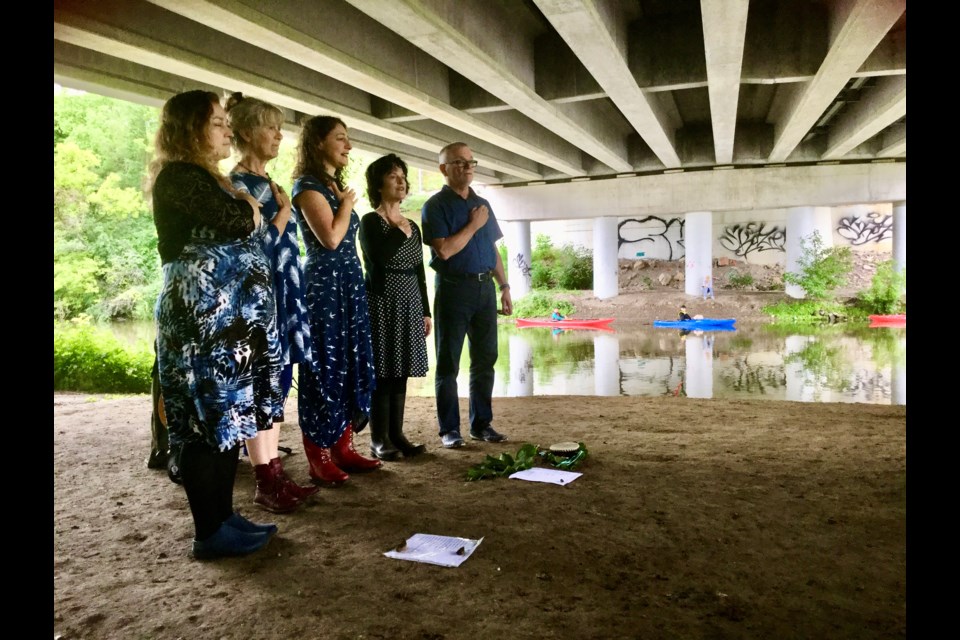The 2Rivers Festival has grown in a number of ways over the past 10 years, moving from a dozen events over a week to more than three dozen events scheduled over two months and there is still room to grow.
“It was Stan Kozak and the Gosling Foundation that called people together from different groups to talk about offering this kind of festival,” said festival steering committee member and co-founder, Susan Ratcliffe. “They gave us a bit of money to start, $2,000 or something like that.”
Most of the seed money provided by the Gosling Foundation went toward promotional costs including the printing of the festival’s iconic and collectable brochure and calendar.
“I have all the brochures from all 10 years,” said Ratcliffe. “I think there were 10 or 12 events for the first one. Each year it has grown in the number of events.”
The 2Rivers Festival was created as a forum for celebrating Guelph’s historic and cultural relationship to the Speed and Eramosa Rivers. It also helped to raise awareness of efforts by the Wellington Water Watchers and other environmental groups to protect and preserve local water resources.
As interest and participation swelled it became clear that a week was not enough time for everyone to quench their thirst for all things water.
“In those first years we tried to compile them over a week then it spread,” said Wellington Water Watchers executive director Arlene Slocombe. “We tried to do the same amount over a month, and we just kept getting more organizations so, now it is two months and a lot of events.”
The first festival in 2012 coincided with the 20th anniversary of the building of the Covered Bridge that spans the Speed River at the confluence of the Speed and Eramosa Rivers.
“At home with my young children and with any visitors who popped by, we made yards and yards of blue yarn, finger knitting to form the colourful roping for our festival ribbons,” said Slocombe. “Then we cut thousands of strips of blue fabric into lengths and tied them on at intervals along the roping. In the end, we created over 300 ft of beautiful festival ribbons.”
The festive atmosphere flowed up and downstream from the Boathouse on Gordon Street with nature walks, canoe tours and water-music performances.
“I think the canoe ballet, the belly dancing and the singing under the bridge with the Ondine Chorus stand out most for me,” said Ratcliffe. “They sang for three or four years under the Victoria Road Bridge next to the river. The sound was gorgeous.”
Of course, a festival of this scope takes a lot of planning and a community of dedicated volunteers.
“We have an amazing core team of volunteers,” said Slocombe. “We work year-round to make this festival happen and for these two months all of them are marshalling all of the events we have. This year we have 38-40 events run by 30 different groups. It really is a community effort.”
The rivers are home to a wide variety of plant and animal species and a major focus of the festival over the years has been on the ecology. The theme for the 10th annual 2Rivers Festival is, “At the confluence of rivers, peoples and their stories.”
Familiar stories of European settlers and their relationship to the river have been shared at past festivals and this year they are sharing stories about the rivers’ influence on successive waves of immigration as well as indigenous communities.
“The Black Heritage Society is doing a story on the history of black people in this area, who settled these river corridors,” said Slocombe. “We have several different events hosted by indigenous people because these waterways were the highways and travel ways of people well before settlers came and occupied the area.”
Reflections from the Black Community will be held on June 16, hosted by Denise Francis and Kween from the Black Heritage Society in partnership with the Guelph Civic Museum.
As part of The Moccasin Identifier Project event, hosted by Carolyn King of the Mississaugas of the Credit First Nations on June 12, people have an opportunity to get their canoes spray-painted with a stencil identifying indigenous communities from the area.
“The idea is that the people of these lands were in part identifiable to each other by their clothing and the type of moccasin they wore,” said Slocombe. “We are bringing those stories, which are missing from our history books. Missing from our ecological stories. Missing from our settler history-based storytelling.”
The pandemic forced organizers last year to cancel events and move what they could online. It was a learning experience in obvious ways and in ways they hadn’t anticipated.
“Last year we essentially tripled our RSVP rate from previous years,” said Slocombe. “In part, that is because people who are maybe from further abroad or people with mobility issues could attend.”
The new inclusiveness extends beyond barriers of geography and mobility to include communities such as 2SLGBTQ+ that, historically, might not have felt welcome or safe at an event made up of “predominantly white middle to upper class, white folks.”
“ARCH are hosting their own event Riverside Poetry Sessions / 2SLGBTQ+ Hike on May 14,” said Slocombe. “The pandemic has revealed many places where truth telling is not happening and It is now incumbent upon us to raise up those stories and tell them and share them and recognize them.”
One thing we all have in common is our dependence on water. It is a necessity for all life on this planet.
“I found myself saying, and maybe it is true in a different way now but, this festival punches way above its weight,” said Slocombe. “It started off as a week of events but because we have 40 events, and we are engaging 30 different organizations it’s actually punching at its weight. We want it to be accessible to everybody.”
To learn more about the 2Rivers Festival visit, www.2riversfestival.org.



